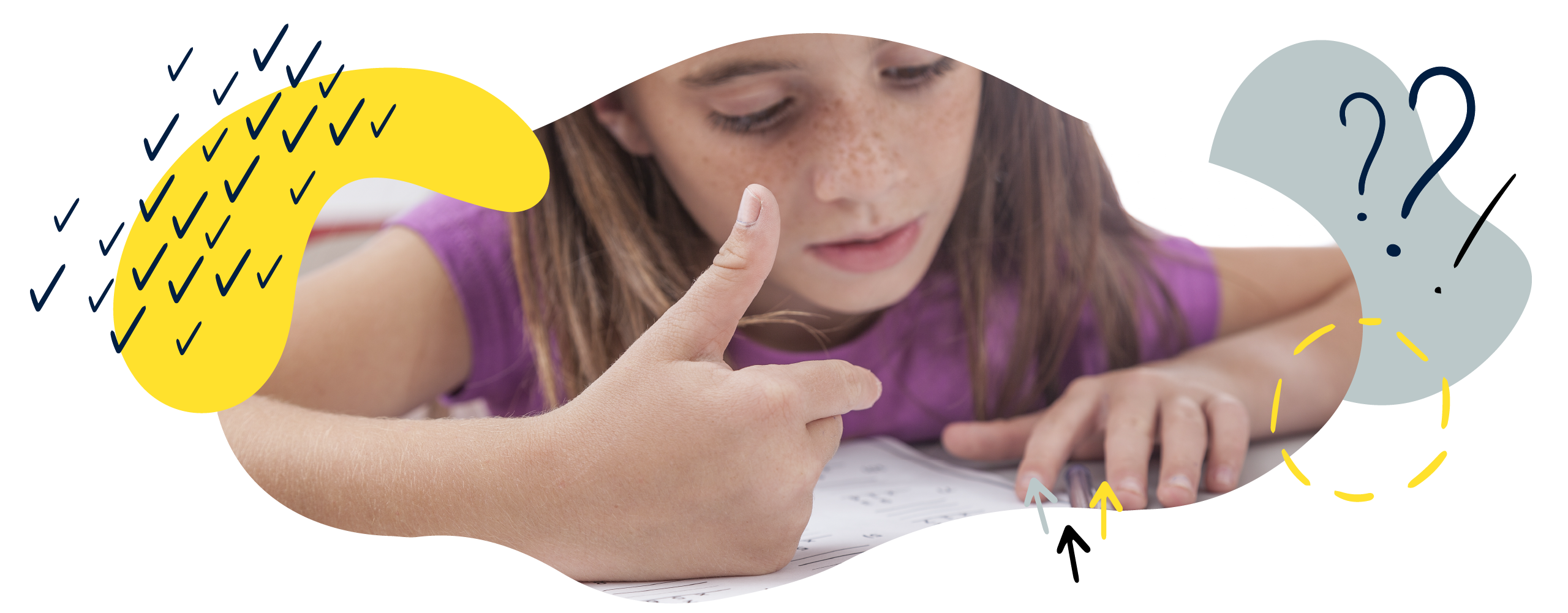

Statistics in Year 2 (age 6–7)
In Year 2, your child will learn to draw simple charts and graphs. They will be able to sort categories by their quantities and will be able to compare sets of data.
The key words for this section are block graph , pictogram , and tally chart .
What your child will learn
Take a look at the National Curriculum expectations for statistics in Year 2 (age 6–7):
Draw pictograms, tally charts, block diagrams, and tables
A pictogram is a graph that uses pictures to represent quantity:

A tally chart uses marks to represent numbers:
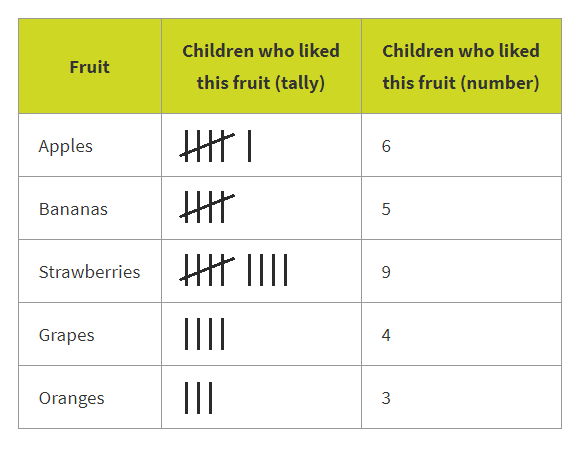
Your child will use block graphs (or block diagrams) where types of items are shown on the x -axis , the number of items is shown on the y -axis , and one block represents one item. A block graph is made up of separate blocks, and children can count the blocks to find out how many are in the group:
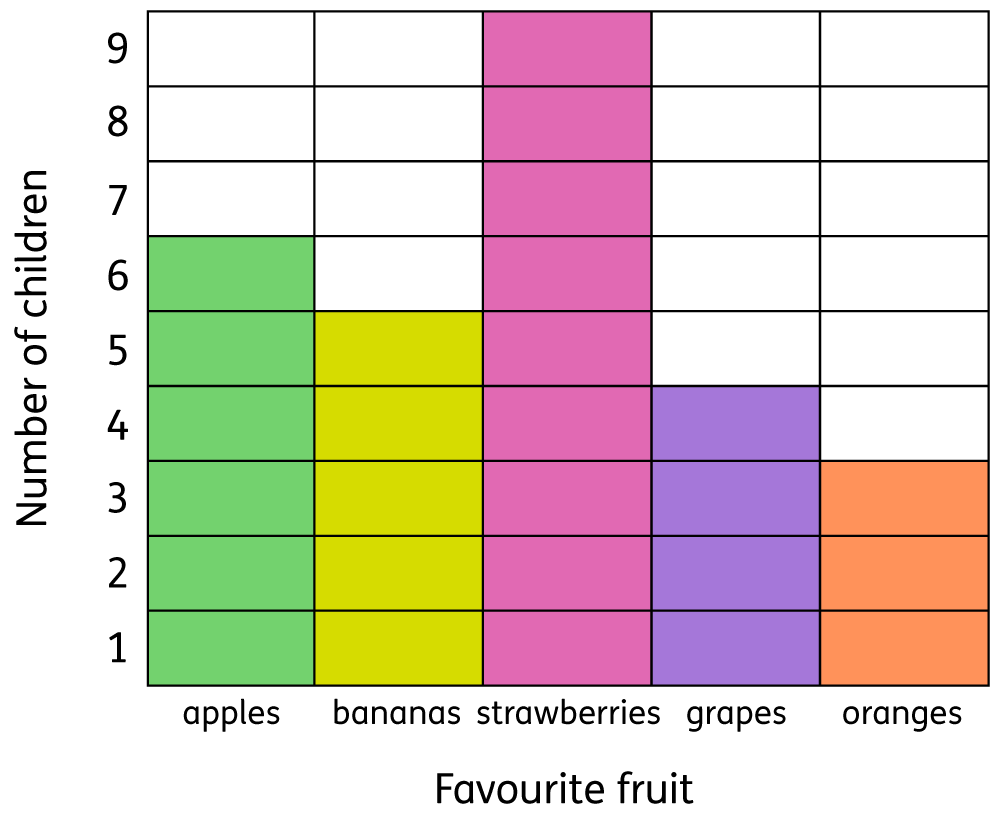
Count objects in multiple category and sort the categories by quantity
Your child will ask and answer simple questions about pictograms , tally charts , block graphs , and simple tables. For example:
How many children like grapes? How many children like apples and bananas? How many more children prefer apples to grapes?
Total and compare categorical data
Your child will ask and answer questions about data they collect. For example:
How many children took part in the survey? What was their most popular option?
How to help at home
There are lots of everyday ways you can help your child to understand statistics. Here are just a few ideas.
1. Present data
In school, your child will be learning to present data with simple tables, pictograms , tally charts , and block graphs . You can encourage your child at home by having them investigate topics that particularly interest them and then present their data in tables, charts, and graphs.
For instance, your child could collect information about the planets in our solar system, favourite book characters, or football. See if they can create their own tables, charts, and graphs to represent the data in new and interesting ways. For example, they could by compare football players by goals scored so far this season.
Your child can record their findings using tables and present them with pictograms or block graphs.
Your child might need extra help when it comes to creating block graphs. Block graphs show types of items on the x -axis , the number of items on the y -axis , and have one block representing each item:
Once your child has practised lots of different ways of showing data, your child should be able to pick when it is best to use a block graph and when it is best to use a different method. They should be able to explain why.
2. Conduct a survey
If your child would prefer to gather their own data, why not do a survey? They could ask family and friends about their favourite food, film, sport, or anything else that takes their fancy.
Encourage your child to analyse their data and discuss any interesting findings. For example, did lots of people have the same favourite food? How many more people chose the most popular choice compared to the least popular choice?
Ask questions about the data they have found and encourage your child to begin asking their own questions, such as, ‘If I asked this question at school, would I get different results?’
3. Interpret data
You can help your child learn to interpret data in the form of tables, pictograms , tally charts , and block graphs by encouraging them to explore interesting topics. For example, if your child is interested in football, encourage them to interpret football team statistics in tables, charts, and graphs. You can find lots of examples online and in football magazines.
Look at non-fiction texts together. Can your child find any data presented in interesting ways? Encourage them to chat about the data they find and point out anything they would not have expected.
- Age 3–4 (Early Years)
- Age 4–5 (Reception)
- Age 5–6 (Year 1)
- Age 6–7 (Year 2)
- Age 7–8 (Year 3)
- Age 8–9 (Year 4)
- Age 9–10 (Year 5)
- Age 10–11 (Year 6)
- Year 1 (age 5–6)
- Year 2 (age 6–7)
- Year 3 (age 7–8)
- Year 4 (age 8–9)
- Year 5 (age 9–10)
- Year 6 (age 10–11)
- Help with times tables
- Ratio & proportion
- Learning to tell the time
- Numicon parent guide
- MyMaths parent guide
- Maths activity books
Mastery-Aligned Maths Tutoring
“The best thing has been the increase in confidence and tutors being there to deal with any misunderstandings straight away."
FREE daily maths challenges
A new KS2 maths challenge every day. Perfect as lesson starters - no prep required!

White Rose Maths Year 2: What Students Learn And The Resources To Support Them
Emma Johnson
Here we look at the White Rose Maths Year 2 scheme of learning , the topics it covers across the year and provide lots of sample questions and White Rose Maths resources for those following White Rose in Year 2.
About White Rose Maths
Year 2 autumn term, year 2 spring term, year 2 summer term, recommended white rose maths year 2 resources, place value year 2, addition & subtraction year 2, shape year 2, money value year 2, multiplication and division year 2, length and height year 2, mass, capacity and temperature year 2, fractions year 2, time year 2, statistics year 2, position and direction year 2.
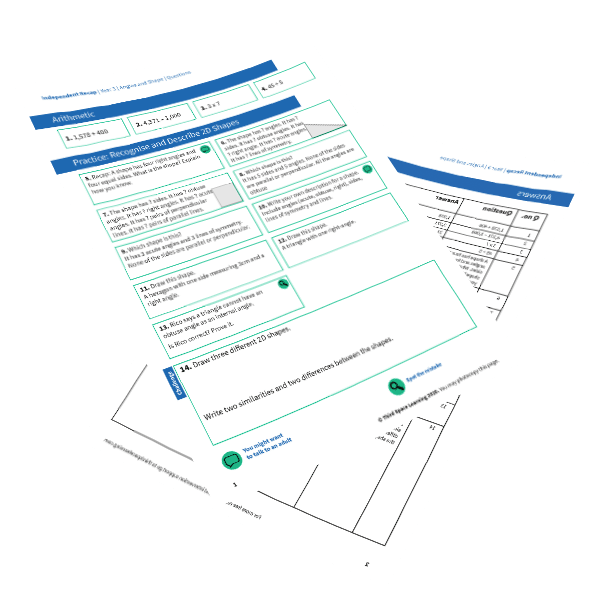
Properties of Shapes Worksheet Year 2
Download this free worksheet to support your Year 2 pupils as they explore the properties of shapes!
The White Rose Maths scheme of learning follows the national curriculum with a mastery approach to maths with a range of fluency, reasoning and problem solving elements. They also encourage concrete, pictorial and abstract representations to develop deep understanding of mathematical concepts.
Read more: White Rose Maths
It is thought that approximately 70% of schools in the UK follow the White Rose Maths scheme and this is reflected in the thousands of students Third Space Learning tutors every week. Our tutors are highly skilled maths and pedagogy experts, well trained in the language, representations and approach used by White Rose. They are therefore able to deliver a one to one lesson that feels familiar to students who are also used to White Rose.
Throughout this article you’ll see example lesson slides and example questions from Third Space Learning’s Year 2 maths curriculum that exemplify best practice teaching to the White Rose Maths Year 2 scheme.
We’ve also provided lots of links to White Rose Maths Year 2 resources that are suitable for use for each topic.In addition to the links provided, Third Space Learning also offers libraries for White Rose Maths Year 1 , White Rose Maths Year 3 , White Rose Maths Year 4 , White Rose Maths Year 5 and White Rose Maths Year 6 .
About the White Rose Maths Year 2 Scheme of Learning
The primary school White Rose Maths scheme of learning has gone through several iterations and versions up to the current version 3. The scheme of learning SOL is designed as guidance and it is not necessarily intended for each small step to take one lesson. As with all teaching, it is important that teachers adapt this SOL for their class/ pupils.
Topics covered in Year 2 White Rose Maths scheme of learning work
The White Rose Maths Year 2 SOL outlines which topics are taught, and when, throughout the autumn, spring and summer terms of Year 2.
The breakdown for Version 3 of the scheme of learning is as follows
- Place value
- Addition and subtraction
- Multiplication and division
- Length and height
- Mass, capacity and temperature
- Position and direction
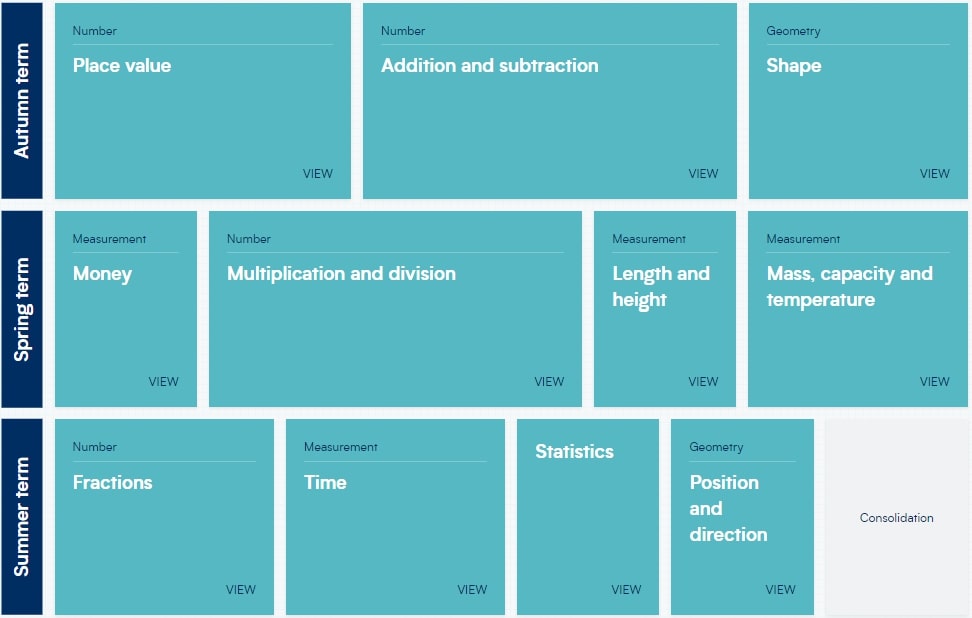
Third Space Learning has created several collections of White Rose Maths aligned resources for all primary year groups from early years through to Year 6. These resources can provide a different perspective on a topic and so help pupils spend the time needed to fully embed a concept.
Here is a summary of the different collections available for schools following Year 2 White Rose Maths, many of them free to download from our maths hub and some are premium resources. Links to the topic specific versions are provided within each termly breakdown below:
Ready to go lesson slides
These ready-to-go lesson slides come in the form of editable powerpoints with related worksheets that are designed for everyday teaching. The slides cover both version 2 of the White Rose scheme of learning (in blue) and version 3 of the scheme of work. They also include support slides that can be used to support pupils who need a little extra pre/ post teaching to support their understanding.
Year 2 ready-to-go lesson slides
Pre and Post Diagnostic Questions
These tests can be used before starting the place value block to assess gaps, and after teaching the place value block to identify progress.
Diagnostic Assessments Year 2
Worked Examples
Pupils check over completed questions to identify errors (or identify correct answers). Pupils are encouraged to explain the errors they find, not just ‘mark’ work. These worked examples help to solidify understanding by getting the pupil to discuss errors and how to avoid them.
Year 2 Worked Examples
White Rose Maths Year 2 autumn term
In the autumn block, Year 2 focuses on place value, addition & subtraction and shape
Place value is a significant proportion of the autumn Year 2 maths curriculum. Students begin the block, focusing on: numbers to 20; counting objects to 100 and recognising tens and ones (using materials and a range of representations to do this). They use a place value chart to partition numbers to hundred and learn to write numbers to 100 in words. Students are also introduced to the < , > and = symbols to compare and order numbers to 100 and learn to count in steps of 2, 3 and 5 from zero.
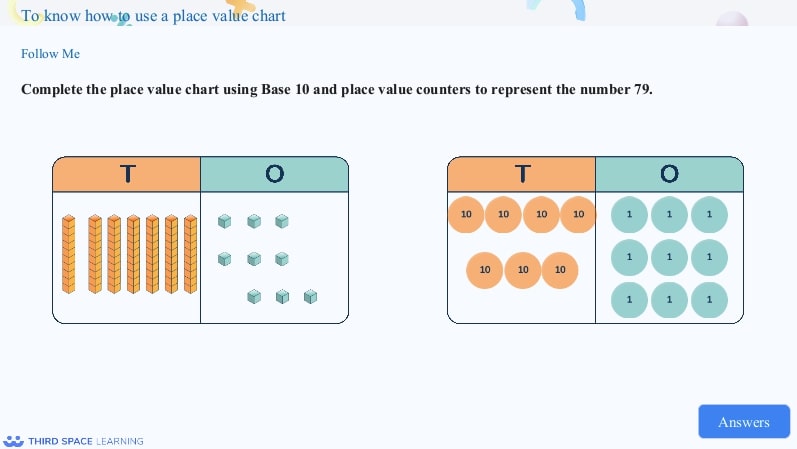
Example year 2 place value questions
1. What number is represented here. How many tens and how many ones are there?
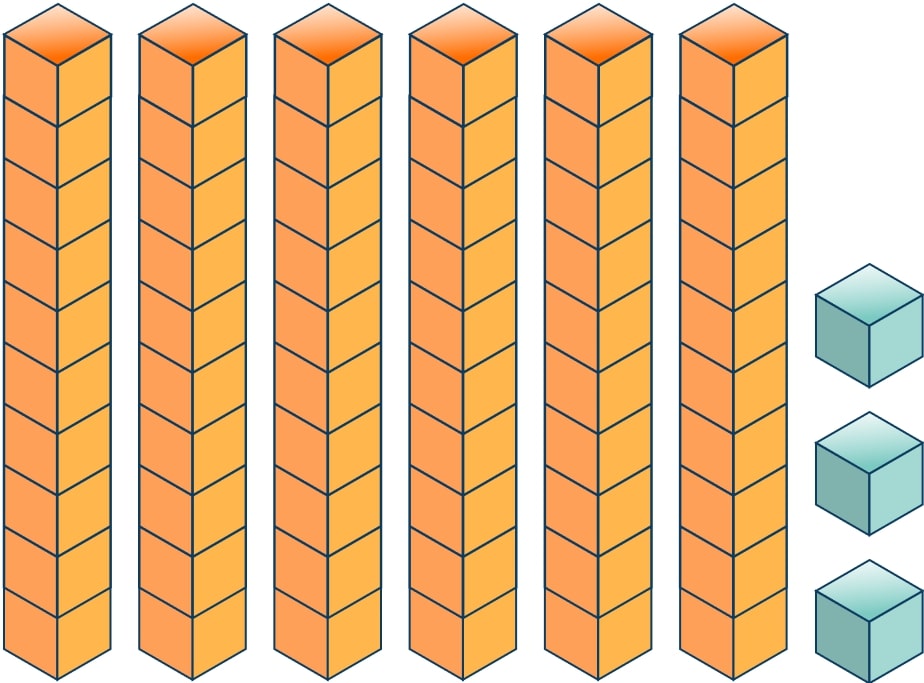
Answer: 63, 6 tens and 3 ones
2. Sam ate 14 grapes and Jamie ate 21. Did Sam eat more or less grapes than Jamie
Answer: Sam ate less grapes
Addition and subtraction is another large block in the year 2 maths curriculum; spanning five weeks. Pupils use concrete objects and pictorial representations, applying their increasing knowledge of mental and written methods and extend their understanding of the language of addition and subtraction to include sum and difference.
Children begin by recapping number bonds to 10. They learn to recall and use addition & subtraction facts to 20 fluently, and derive and use related facts up to 100. Pupils also use concrete objects and pictorial representations to add and subtract: two-digit numbers and ones; two-digit numbers and tens; two two-digit numbers and three one-digit numbers. They also learn to recognise and use the inverse relationship between addition and subtraction and use this to check calculations and solve missing number problems.
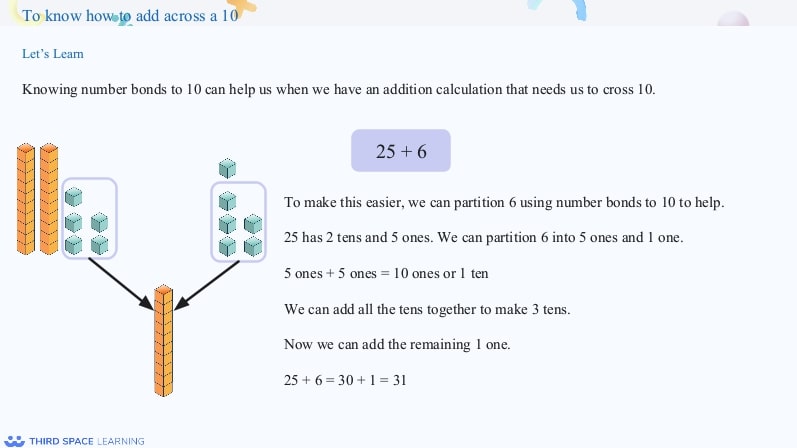
Example year 2 addition & subtraction questions
1a) 24 + 3 =
b) 57 – 4 =
2. Sophie had 7 pencils. She gave 3 pencils to her friend. How many did she have left?
Answer: 4 pencils
Shape is the final block of the autumn term. Pupils learn to identify and describe the properties of a range of 2D, including number of sides and lines of symmetry and 3D shapes, including the number of edges, faces and vertices . Students also learn to read and write the names for the shapes; sort shapes and make patterns with both 2D and 3D shapes.
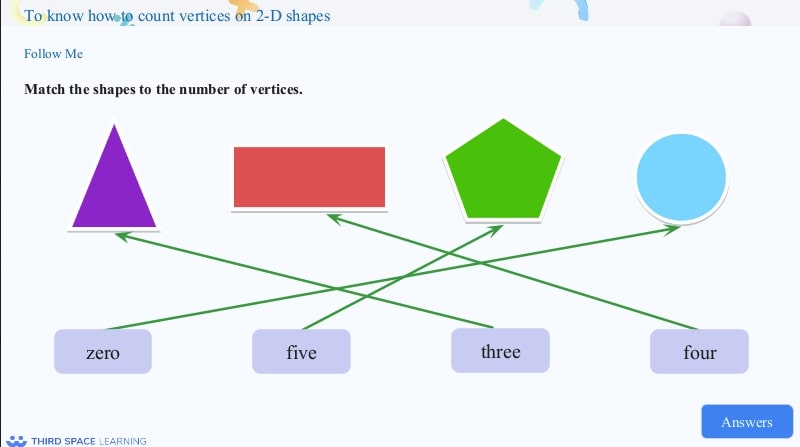
Example year 2 shape questions
1. Match the shape to the correct name:
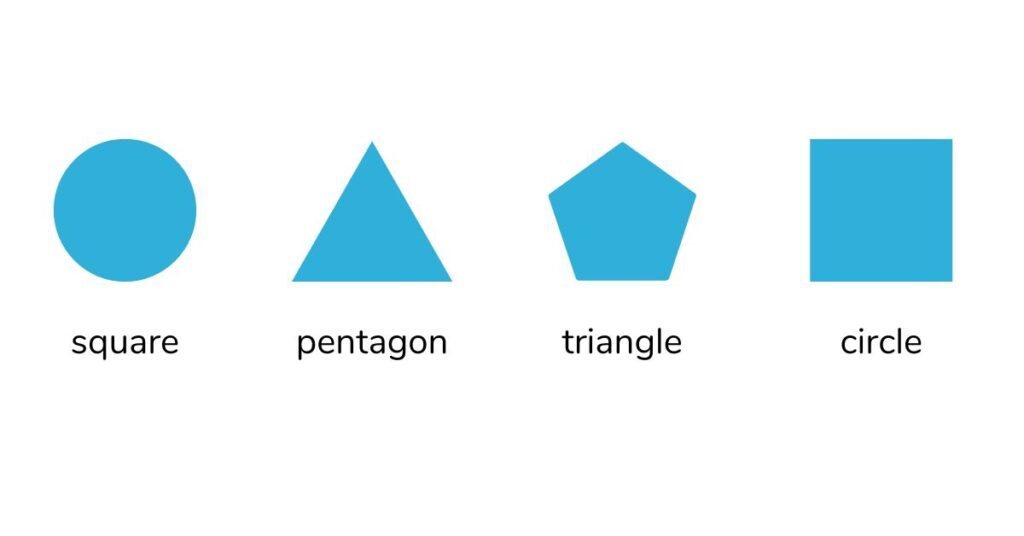
White Rose Maths Year 2 spring term
In the spring block Year 2 focuses on money, multiplication & division, length & height, and mass, capacity & temperature.
Pupils build on their knowledge of coins from year 1, learning to recognise and use symbols for pounds and pence and combining amounts to make a particular value. Students also learn to find different combinations of coins that equal the same amounts and solve simple problems involving the addition and subtraction of money, including giving change.
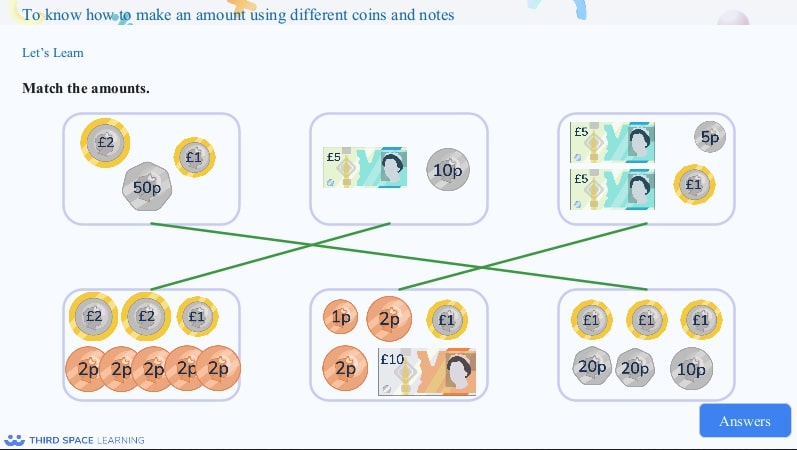
Example year 2 money questions
1. Count the money. How much is there in total?
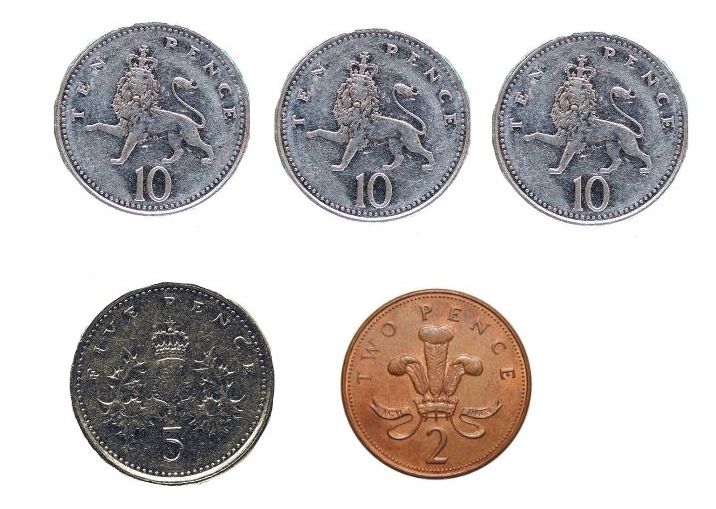
Answer: 37p
2. Mason bought a lolly for 7p and a bag of sweets for 25p. How much did he spend altogether?
Answer: 32p
Multiplication and division is one of the largest blocks in the year 2 maths curriculum, spanning 5 weeks in total. Pupils learn to recall the multiplication and division facts and times tables for the 2, 5 and 10 multiplication tables and are introduced to the multiplication symbol. Children work with a range of practical resources and investigate a range of contexts in which multiplication and division relate to grouping and sharing, to arrays and to repeated addition.
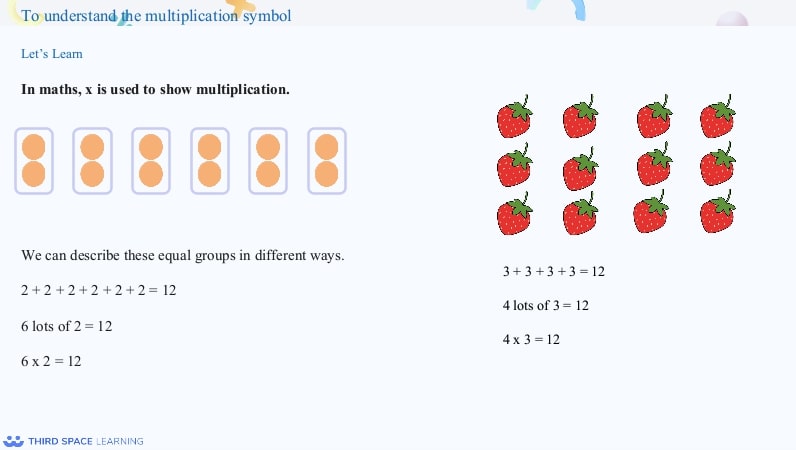
Example year 2 multiplication and division questions
1. There are 8 pencils in a pack. How many are there in 2 packs?
2. Hamza shares his 20 sweets between him and his 4 friends. How many sweets do each of the 5 children get?
Answer: 5 sweets each
Pupils build on their understanding of measures from year 1, to begin using standard units of measurement with increasing accuracy. Children learn to measure in centimetres and metres and to compare and order lengths & heights.

Example year 2 length and height questions
1. What is the length of the toy car?
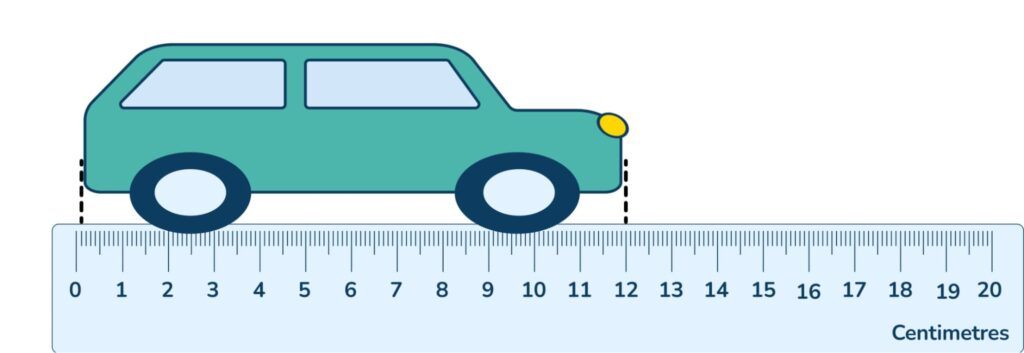
Can you put a ruler this and a picture of something like a toy car, for children to measure?
Answer: 12cm
In year 2, pupils are introduced to mass, capacity and temperature, and learn to measure in grams, kilograms, millilitres and litres. The four operations are used to solve problems with both mass and capacity and children begin using ℃ to describe temperature.
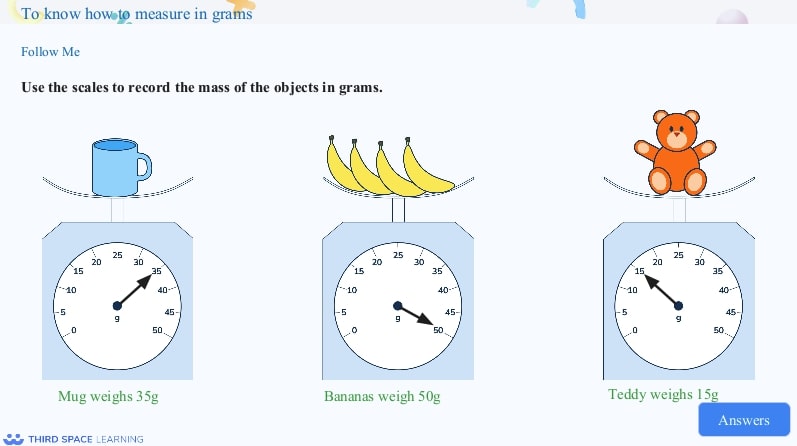
Example year 2 mass, capacity and temperature questions
1. What is the capacity of the jug?
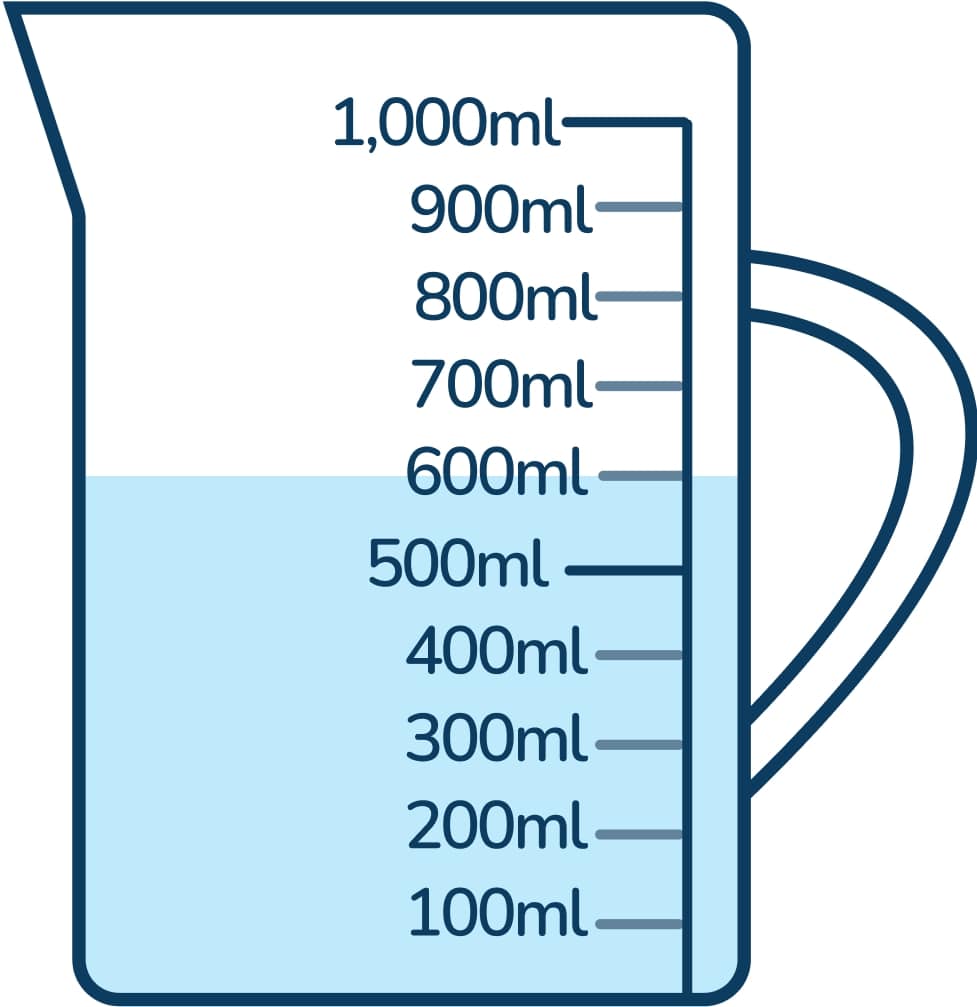
Answer: 600ml
2. Maisie is doing some baking. She measured out 50g of flour and 25g of sugar. How much flour and sugar does she have altogether?
Answer: 75g
White Rose Maths Year 2 summer term
In the summer block Year 2 focuses on: fractions, time, statistics and position & direction.
In year 2, pupils begin by exploring the concept of parts/whole and equal/unequal parts. Children learn to recognise and find a half, a third and a quarter and are introduced to the terms ‘unit’ and ‘non-unit’ fraction. Pupils also solve problems using shapes, objects and quantities and learn how to count in fractions up to a whole.
Example year 2 fractions questions
1. Colour in the fraction given on each shape.
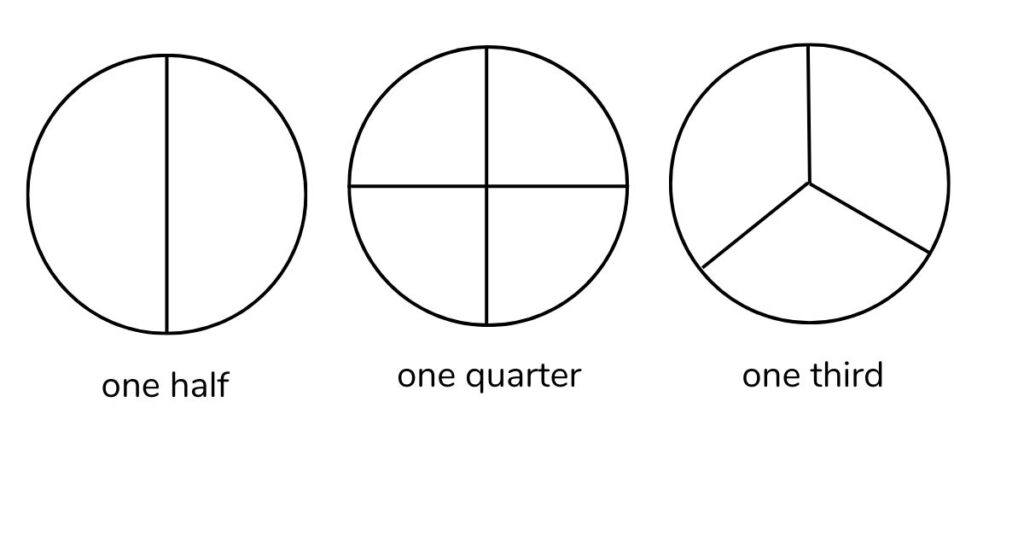
2. Abdulla had 14 sweets. He gave half of them to his friend. How many sweets did he have left?
Answer: \frac{1}{2} of 14 = 7 sweets
In year 2, pupils become more fluent in telling the time on an analogue clock; progressing from telling the time to o’clock and half past, to learning to read the time to five minutes, including quarter past and quarter to. By this stage, children should also know how many minutes in an hour and the number of hours in a day.
Example year 2 time questions
1. Draw hands on the clock so it is showing 20 past 5.
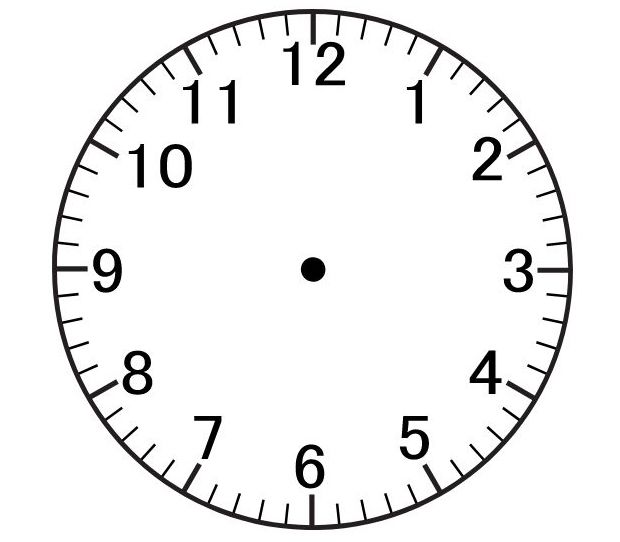
2. Oliver got on the bus at 10 o’clock and got off again at half past 10. How long was he on the bus for?
Answer: Half an hour / 30 minutes
Pupils record, interpret, collate, organise and compare information. They learn to construct simple pictograms, tally charts, block diagrams and tables and answer questions by counting the number of objects in each category and sorting the categories by quantity.
Example year 2 statistics questions
1. Zanab carried out a survey on the favourite foods for children in her year group. She recorded the results as a tally chart.
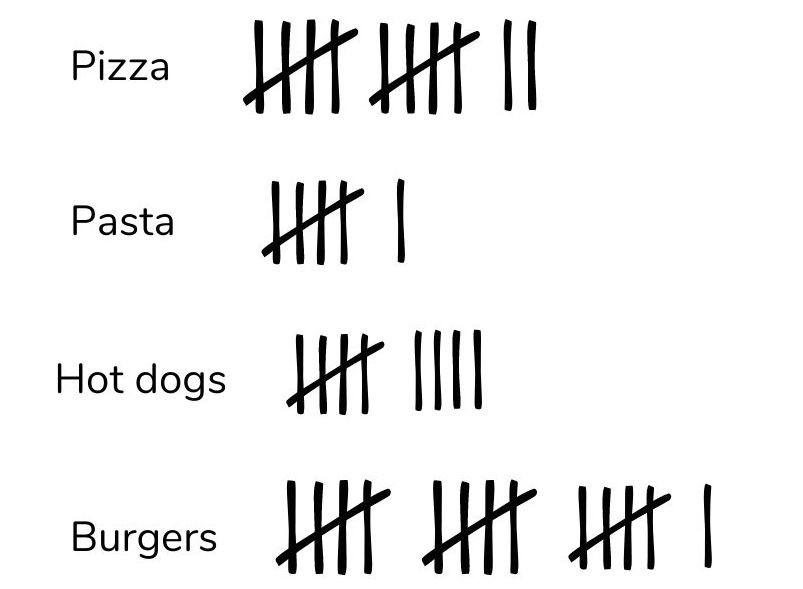
a) What was the most popular food?
b) Which was the least popular food?
c) How many children chose hot dogs as their favourite food?
d) How many more children chose pizza than pasta?
c) 9 children
d) 6 more children
In year 2, pupils learn to describe movement and turns, using the language of angles. They also learn to work with patterns of shapes, including those in different orientations.
Example year 2 position & direction questions
1. a) Use the words forwards, backwards, left and right to plan a route home for the cat.
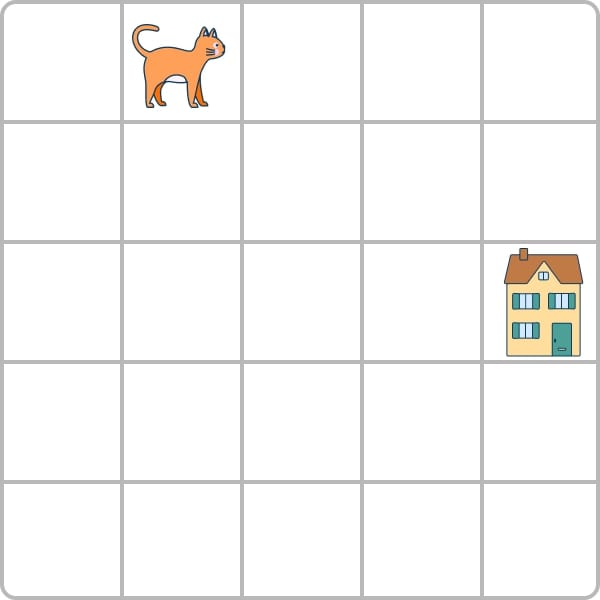
Answer: 3 squares forwards and 2 squares right (other routes are possible, for example 2 squares down and 3 squares right)
DO YOU HAVE STUDENTS WHO NEED MORE SUPPORT IN MATHS?
Every week Third Space Learning’s specialist online maths tutors support thousands of students across hundreds of schools with weekly online 1 to 1 maths lessons designed to plug gaps and boost progress.
Since 2013 these personalised one to one lessons have helped over 150,000 primary and secondary students become more confident, able mathematicians.
Learn how the programmes are aligned to maths mastery teaching or request a personalised quote for your school to speak to us about your school’s needs and how we can help.
Related articles

Maths Problem Solving: Engaging Your Students And Strengthening Their Mathematical Skills

Free Year 7 Maths Test With Answers And Mark Scheme: Mixed Topic Questions

What Is A Number Square? Explained For Primary School Teachers, Parents & Pupils
What Is Numicon? Explained For Primary School Teachers, Parents And Pupils
FREE Guide to Maths Mastery
All you need to know to successfully implement a mastery approach to mathematics in your primary school, at whatever stage of your journey.
Ideal for running staff meetings on mastery or sense checking your own approach to mastery.
Privacy Overview
Popular searches in the last week:
Problem-solving maths investigations for year 2.
Hamilton provide an extensive suite of problem-solving maths investigations for Year 2 to facilitate mathematical confidence, investigative inquiry and the development of maths meta skills in 'low floor – high ceiling' activities for all.
Explore all our in-depth problem solving investigations for Year 2 .
Use problem-solving investigations within every unit to encourage children to develop and exercise their ability to reason mathematically and think creatively.
Investigations provide challenges that offer opportunities for the development of the key mathematical skills while deepening conceptual understanding. They are designed to be accessible in different ways to all children. An added bonus is the substantial amount of extra calculation practice they often incorporate! The problems are designed to help children identify patterns, to explore lines of thinking and to reason and communicate about properties of numbers, shapes and measures.
Hamilton provide a mix of our own specially commissioned investigations, that include guidance for teachers together with a child-friendly sheet to guide your pupils through the investigation, as well as links to investigations on other highly regarded websites.
I am very grateful for Hamilton Trust resources, particularly the maths investigations. Julia, teacher in Wiltshire
You can find Hamilton's investigations for Year 2:
- Individually, they are incorporated into every unit in our Year 2 flexible maths blocks .
- Collectively, they appear on our resources page where you can explore all our in-depth problem solving investigations for Year 2 .
Do read our extensive range of advice for more information about the investigations and for tips on how to use them effectively.
Hamilton’s problem-solving investigations are 'low floor, high ceiling' activities that give all children opportunities to develop mastery and mathematical meta-skills. Explore a set for a whole year group.
Hamilton’s Problem-solving Investigations provide school-wide solutions to the challenges of building investigative skills from Early Years to Year 6.
This site uses cookies to give you the most relevant information. Learn more
Log in or sign up to get access to this resource
School subscription, reduce teacher workload.
From £155 (+ VAT) per year. Access to all key stages for multiple users.
Individual Subscription
For inspirational teaching.
Just £45 (£37.50 + VAT) per year to get access to all resources.
Early Career Teacher
Develop your teaching.
Just £33 (£27.50 + VAT) to get access to all resources for 2 years.
Taster Account
100s of resources.
Register to access all free resources.
Already subscribed?
Log in to get access.
- Home |
- About |
- Contact Us |
- Privacy |
- Newsletter |
- Shop |
- 🔍 Search Site
- Easter Color By Number Sheets
- Printable Easter Dot to Dot
- Easter Worksheets for kids
- Kindergarten
- All Generated Sheets
- Place Value Generated Sheets
- Addition Generated Sheets
- Subtraction Generated Sheets
- Multiplication Generated Sheets
- Division Generated Sheets
- Money Generated Sheets
- Negative Numbers Generated Sheets
- Fraction Generated Sheets
- Place Value Zones
- Number Bonds
- Addition & Subtraction
- Times Tables
- Fraction & Percent Zones
- All Calculators
- Fraction Calculators
- Percent calculators
- Area & Volume Calculators
- Age Calculator
- Height Calculator
- Roman Numeral Calculator
- Coloring Pages
- Fun Math Sheets
- Math Puzzles
- Mental Math Sheets
- Online Times Tables
- Online Addition & Subtraction
- Math Grab Packs
- All Math Quizzes
- 1st Grade Quizzes
- 2nd Grade Quizzes
- 3rd Grade Quizzes
- 4th Grade Quizzes
- 5th Grade Quizzes
- 6th Grade Math Quizzes
- Place Value
- Rounding Numbers
- Comparing Numbers
- Number Lines
- Prime Numbers
- Negative Numbers
- Roman Numerals
- Subtraction
- Add & Subtract
- Multiplication
- Fraction Worksheets
- Learning Fractions
- Fraction Printables
- Percent Worksheets & Help
- All Geometry
- 2d Shapes Worksheets
- 3d Shapes Worksheets
- Shape Properties
- Geometry Cheat Sheets
- Printable Shapes
- Coordinates
- Measurement
- Math Conversion
- Statistics Worksheets
- Bar Graph Worksheets
- Venn Diagrams
- All Word Problems
- Finding all possibilities
- Logic Problems
- Ratio Word Problems
- All UK Maths Sheets
- Year 1 Maths Worksheets
- Year 2 Maths Worksheets
- Year 3 Maths Worksheets
- Year 4 Maths Worksheets
- Year 5 Maths Worksheets
- Year 6 Maths Worksheets
- All AU Maths Sheets
- Kindergarten Maths Australia
- Year 1 Maths Australia
- Year 2 Maths Australia
- Year 3 Maths Australia
- Year 4 Maths Australia
- Year 5 Maths Australia
- Meet the Sallies
- Certificates
Year 2 Maths Worksheets UK Hub Page
Welcome to Math Salamanders Year 2 Maths Worksheets hub page.
In our Year 2 area, you will find a wide range of printable math worksheets and Maths activities for your child to enjoy.
Come and take a look at our dot-to-dot pages, or our maths games. Perhaps you would prefer our 2d shape worksheets, or learning about numbers using our number line worksheets?
Hopefully you will find something here to meet your child's maths requirements!
For full functionality of this site it is necessary to enable JavaScript.
Here are the instructions how to enable JavaScript in your web browser .
- This page contains links to other Math webpages where you will find a range of activities and resources.
- If you can't find what you are looking for, try searching the site using the Google search box at the top of each page.
Year 2 Maths Learning
Here are some of the key learning objectives for the end of Year 2:
- know and use Place value up to 100
- Compare and order numbers up to 100
- Counting on and back in 1s and 10s
- count in 2s, 5s and 10s
- Position numbers on a number line up to 1000
- use addition and subtraction facts to 20
- use related facts for addition and subtraction
- add or subtract 1 or 10 from a 2-digit number
- add and subtract 2-digit numbers
- number bonds to 100 using tens only
- add three single-digit numbers
- recognise and make equal groups
- use the x symbol to write multiplication sentences
- use arrays and pictures to represent multiplication sentences
- know multiplication facts for the 2, 5 and 10 times table
- recognise and find a half, a quarter and a third
- understand and use fraction notation
- understand the equivalence of a half and two-quarters
- count on in halves, thirds and quarters up to 10
- count in pence: 1p, 2p ,5p, 10p and 20p
- count in pounds: £1, £2, £5, £10 and £20
- find a simple total or difference between two money amounts
- find the change from simple amounts
- tell the time: o'clock, half-past, quarter-past and to
- understand and compare durations of time
- compare and measure length, mass, volume, capacity and temperature
- read a variety of scales going up in 1s, 2s, 5s and 10s
- recognise 2D and 3D shapes
- count sides and vertices on 2D shapes
- count faces, edges and vertices on 3D shapes
- sort and make patterns with 2D and 3D shapes
- describe movement and turns
- make tally charts
- draw and interpret pictograms
- understand and use block diagrams
Please note:
Our site is mainly based around the US Elementary school math standards.
Though the links on this page are all designed primarily for students in the US, but they are also at the correct level and standard for UK students.
The main issue is that some of the spelling is different and this site uses US spelling.
Year 2 is generally equivalent to 1st Grade in the US.
On this page you will find link to our range of math worksheets for Year 2.
Quicklinks to Year 2 ...
- Place Value Zone
Operations Zone
- Mental Math Zone
Word Problems Zone
- Measurement Zone
Geometry Zone
Data analysis zone.
- Fun Zone: games and puzzles
Coronavirus Stay At Home Support
For those parents who have found themselves unexpectedly at home with the kids and need some emergency activities for them to do, we have started to develop some Maths Grab Packs for kids in the UK.
Each pack consists of at least 10 mixed math worksheets on a variety of topics to help you keep you child occupied and learning.
The idea behind them is that they can be used out-of-the-box for some quick maths activities for your child.
They are completely FREE - take a look!
- Free Maths Grabs Packs
Place Value & Number Sense Zone
Year 2 Place Value Charts
Here you will find a range of Free Printable Place Value Charts for Year 2.
These printable charts will help your child learn to read and write numbers.
Some of the charts are partially filled to help your child learn their place value.
Using these sheets will help your child to:
- learn to count in tens and ones;
- learn to read and write numbers.
- Printable Number Charts 0-99
- Hundred Number Charts (100 Squares)
- Number Grid up to 200
Place Value and Counting Worksheets
Here you will find a range of Year 2 Place Value Worksheets.
These Year 2 maths worksheets will help your child learn their place value, reading, writing and ordering numbers up to 100.
There are also some money worksheets involving counting in dimes and pennies to support place value learning.
- learn to order numbers to 100;
- learn to count in dimes and pennies;
- learn to read and write numbers to 100.
Year 2 Place Value Worksheets
- Place Value to 20 Worksheets
- Math Place Value Worksheets Tens and Ones
- Ordering 2-digit numbers Worksheets
- Greater than Less than Worksheets - up to 2 digit numbers
- Printable Counting Worksheets to 50
- Missing Number Chart 1-100
- Counting by 2s Worksheets
- Math Worksheets Counting by 1s 5s and 10s
Number Line Worksheets
Here is our selection of free printable number line worksheets for Year 2 pupils.
These first grade math worksheets will give your child a good grasp of place value and number sequences up to 100.
- count on and back by ones;
- position numbers to 100 on a number line.
- Number lines to 20
- Number lines to 100
Year 2 Mental Maths Zone
Here you will find a range of printable mental math sheets designed especially for Year 2 children.
Each quiz tests the children on a range of math topics from number facts and mental arithmetic to geometry, solving word problems and measures questions.
A great way to revise topics, or use as a weekly math quiz!
- Year 2 Printable Mental Maths
Top of Page
Year 2 Addition Worksheets
Here you will find a range of Free Printable Addition Worksheets to support Year 2.
The following first grade math worksheets involve adding different amounts.
- learn their addition facts to 12+12;
- learn to solve an addition fact where one of the addends is missing;
- learn to add numbers in columns up to 100.
- Number Bonds to 10 and 12
- Addition Sentences to 12
- Addition Fact Practice to 12
- Addition Facts to 20 Worksheets
- Adding tens
- Addition Word Problems
- 2 Digit Addition Without Regrouping
- 2 Digit Addition Worksheets With Regrouping
- Free Addition Worksheets (randomly generated)
Year 2 Subtraction Worksheets
Here you will find a range of Year 2 Subtraction Worksheets.
The following worksheets involve using the Math skills of subtracting.
Using these Year 2 maths worksheets will help your child to:
- learn their addition and subtraction facts to 12;
- learn to subtract 2 digit numbers.
- Subtraction Facts to 12
- Subtracting tens
- Subtraction Word Problems
- Two Digit Subtraction Worksheets Without Regrouping
- 2 Digit Subtraction Worksheets With Regrouping
- Free Subtraction Worksheets (randomly generated)
Addition & Subtraction Worksheets
If you need to mix and match addition and subtraction fact questions within the same sheet, then use this section here.
The addition and subtraction worksheets involve counting on and back with numbers to 12.
- Math Activities Addition and Subtraction to 12
- Add and Subtract 10 Worksheets
- Addition Subtraction Worksheets (randomly generated)
- Addition and Subtraction Problems
Year 2 Maths Word Problems
Here you will find a range of math word problems aimed at Year 2 level. Each problem sheet is based on an interesting theme such as parties or the seaside.
- Add and subtract with numbers to 12;
- order numbers to 100;
- solve a range of math problems.
- Maths Problems for Year 2
Longer Math Problems
- Year 2 Maths Problems (1st Grade)
Year 2 Geometry Worksheets
Here is a range of free geometry worksheets for Year 2 pupils.
The following worksheets will help your child to:
- Identify and name a range of 2d and 3d shapes;
- Draw 2d shapes;
- Know some of the properties of 2d shapes.
- Year 2 Geometry Worksheets (1st Grade)
Measurement Zone, including Time & Money
Year 2 measurement worksheets.
Here is our selection of measurement worksheets for Year 2 pupils.
These sheets involve reading scales going up in ones to find the weight or liquid capacity.
Using these sheets will help children to consolidate their counting as well as learning to read a simple scale.
- Year 2 Measurement Worksheets (1st Grade)
Year 2 Money Worksheets
Here you will find a range of free printable First Grade Money Worksheets.
The following worksheets involve counting different amounts of money in pennies, nickels and dimes.
- learn the names and values of the US coins;
- learn to count up different amounts of money to £1 in coins.
- Free Counting Money Worksheets UK Coins (easier)
- Free Money Worksheets UK Coins up to £1
Printable Money Resources
- Printable Money Flashcards
- Kids Counting Money Dominoes
Telling the Time Worksheets
Here is our selection of telling the time worksheets for 1st grade.
- read o'clock and half-past times;
- convert o'clock and half-past times to digital;
- draw clock hands correctly to mark out o'clock and half-past.
The year 2 maths worksheets in this section will help your child learn to tell simple times on an analogue clock.
- Telling Time Worksheets o'clock and half-past
- Clock Worksheets - Quarter Past and Quarter To
Year 2 Bar Graph Worksheets
Here is our selection of bar graphs for first graders.
These Year 2 maths worksheets involve reading and interpreting a range of bar graphs and picture graphs with a scale going up in ones.
Using these sheets will help children to understand how bar graphs work.
- Year 2 Picture/Bar Graphs (First Grade)
Fun Zone: Puzzles, Games and Riddles
Year 2 Maths Games
Here you will find a range of free printable Math games. All children like to play Math games, and you will find a good range of Maths Games at a Year 2 level here for your child to play and enjoy.
- Year 2 Maths Games (First Grade)
Year 2 Maths Puzzles
Here you will find a range of printable Year 2 level math puzzles for your child to enjoy.
The puzzles will help your child practice and apply their addition and subtraction facts as well as developing their thinking and reasoning skills in a fun and engaging way.
Using these puzzles will help your child to:
- develop thinking and reasoning skills;
- develop perseverance.
- Year 2 Maths Puzzles (1st Grade)
- Dot to Dot up to 50
Math Salamanders Year 2 Maths Games Ebook
Our Year 2 Maths Games Ebook contains all of our fun maths games, complete with instructions and resources.
This ebooklet is available in our store - use the link below to find out more!
- Year 2 Maths Games Ebook
Other UK Maths Worksheet pages
See below for our other maths worksheets hub pages designed for children in the UK.
How to Print or Save these sheets 🖶
Need help with printing or saving? Follow these 3 steps to get your worksheets printed perfectly!
- How to Print support
Subscribe to Math Salamanders News
Sign up for our newsletter to get free math support delivered to your inbox each month. Plus, get a seasonal math grab pack included for free!

- Newsletter Signup
Return to Math Salamanders UK Home Page
Return from Year 2 Maths Worksheets to Math Salamanders Home Page
Math-Salamanders.com
The Math Salamanders hope you enjoy using these free printable Math worksheets and all our other Math games and resources.
We welcome any comments about our site or worksheets on the Facebook comments box at the bottom of every page.
New! Comments
TOP OF PAGE
© 2010-2024 Math Salamanders Limited. All Rights Reserved.
- Privacy Policy
- Copyright Policy

Or search by topic
Number and algebra
- The Number System and Place Value
- Calculations and Numerical Methods
- Fractions, Decimals, Percentages, Ratio and Proportion
- Properties of Numbers
- Patterns, Sequences and Structure
- Algebraic expressions, equations and formulae
- Coordinates, Functions and Graphs
Geometry and measure
- Angles, Polygons, and Geometrical Proof
- 3D Geometry, Shape and Space
- Measuring and calculating with units
- Transformations and constructions
- Pythagoras and Trigonometry
- Vectors and Matrices
Probability and statistics
- Handling, Processing and Representing Data
- Probability
Working mathematically
- Thinking mathematically
- Mathematical mindsets
- Cross-curricular contexts
- Physical and digital manipulatives
For younger learners
- Early Years Foundation Stage
Advanced mathematics
- Decision Mathematics and Combinatorics
- Advanced Probability and Statistics
Handling Data KS2
This collection is one of our Primary Curriculum collections - tasks that are grouped by topic.
How Big Are Classes 5, 6 and 7?
Use the two sets of data to find out how many children there are in Classes 5, 6 and 7.
Take Your Dog for a Walk
Use the interactivity to move Pat. Can you reproduce the graphs and tell their story?
Real Statistics
Have a look at this table of how children travel to school. How does it compare with children in your class?
Venn Diagrams
How will you complete these interactive Venn diagrams?

The Car That Passes
What statements can you make about the car that passes the school gates at 11am on Monday? How will you come up with statements and test your ideas?
Class 5's Names
Class 5 were looking at the first letter of each of their names. They created different charts to show this information. Can you work out which member of the class was away on that day?
The Domesday Project
Take a look at these data collected by children in 1986 as part of the Domesday Project. What do they tell you? What do you think about the way they are presented?
If the World Were a Village
This activity is based on data in the book 'If the World Were a Village'. How will you represent your chosen data for maximum effect?
This problem explores the range of events in a sports day and which ones are the most popular and attract the most entries.
Going for Gold
Looking at the 2012 Olympic Medal table, can you see how the data is organised? Could the results be presented differently to give another nation the top place?
Now and Then
Look at the changes in results on some of the athletics track events at the Olympic Games in 1908 and 1948. Compare the results for 2012.


Home / Year 2 – Problem Solving (3) | Problem Solving
Year 2 – Problem Solving (3) | Problem Solving

A range of mix-topic challenge cards requiring children to use their problem solving and reasoning skills.
- Curriculum Links
Tried this resource? Add a photo Add a photo
What worked / did not work well? Have you spotted an error? Any other comments? Leave Feedback Leave Feedback
Related Products
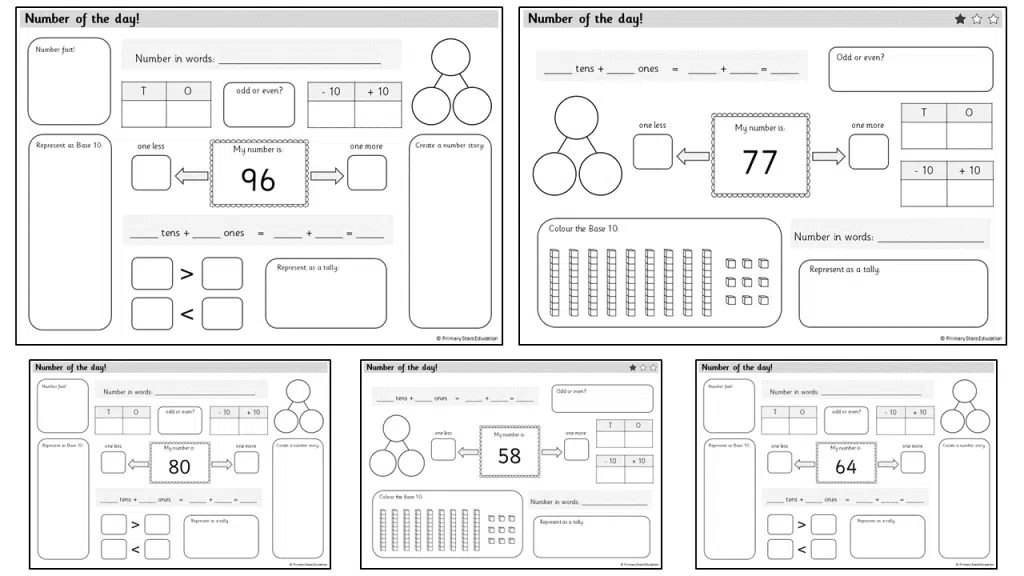
Number of the day (within 100) | Activity

Number of the day (within 50) | Activity

Number of the day (within 20) | Activity

Subtraction grids (within 100) | Activity

Addition grids (within 100) | Activity

Subtraction grids (within 20) | Activity
Let us know..., login failed, ks1 upgrade....
If you wish to upgrade your subscription to Key Stage 1 please contact [email protected] or head over to our support page .
Please upgrade to a premium account to download this resource.
Please Log In
Please log in or sign up to access this feature.
Please log in or sign up to save this resource.
Invoice Request
This resource is not included in your Year 2 subscription.
Upgrade below to gain access to all premium resources
This resource is not included in your Year 1 subscription.
Upgrade below to gain access to all premium resources!
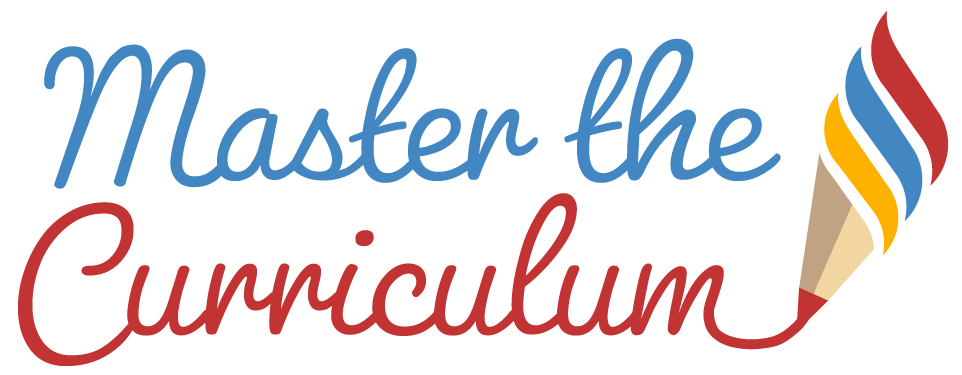
Year 2 Maths Worksheets and Teaching Resources
Gain access to our Year 2 Resources here
Year 2 is an exciting time for children. They’ve completed their first year of formal education and they’re ready to tackle more advanced lessons.
Children will spend Year 2 working towards the end of their Key Stage 1 journey. They’ll continue developing foundational knowledge in core subjects and by the end of the year, they’ll be ready and keen to embrace more complex lessons and a more independent learning style.
As for Year 2 maths, children will consolidate their knowledge of maths fundamentals while developing their maths reasoning and problem-solving abilities. When it comes to making sure children engage with the Year 2 maths curriculum, learning resources are hugely important. The best learning materials will help children see just how fun maths can be — they’ll get children excited to learn.
Master the Curriculum is here to provide teachers and parents with all of the Year 2 maths resources they need to help children embrace learning with a smile. From maths worksheets to teaching slides, to interactive videos, our resources can help children master maths and have fun while doing so.
Editable Worksheets
Downloadable Lesson Plans
White Rose Supporting
Reasoning Maths resources
What Types Of Year 2 Teaching Resources Do We Offer?

Year 2 White Rose Maths Resources: Learning Materials That Support Teaching For Mastery
Millions of parents, teachers and children all over the UK have discovered the incredible benefits of the White Rose Maths approach. White Rose is all about teaching for mastery, showing all children that they have the potential to become confident mathematicians and encouraging little ones to have fun with number problems.
Here at Master the Curriculum, we’re big fans of the White Rose approach, which is why our Year 2 maths resources are aligned with the White Rose Maths frameworks and small steps to progression.By using our resources to follow the White Rose small steps, you can help children become enthusiastic maths whizzes. They’ll develop a deep understanding of basic maths concepts, and with strong foundational knowledge, they’ll be ready and excited to tackle more challenging number problems as the year goes on.
Our White Rose-style resources are also differentiated (by complexity, not by number), making them perfect for children with varying levels of attainment. Pupils who grasp concepts more quickly than others can deepen their understanding with more complex fluency tasks, rather than move on to new content and topics ahead of their classmates. This way, you can make sure your whole class moves through content at the same pace — no one falls behind or misses out on learning opportunities.
Want to learn more about White Rose Maths and how our resources support this approach? Head over to our Supporting White Rose Maths Hub, where you’ll find everything you need to know and more!

The Year 2 Maths Curriculum: What Will Children Learn?
The Year 2 maths curriculum focuses on making sure children develop a breadth of mathematical knowledge. The lessons children learn during this school year will act as the building blocks for more advanced learning when they progress to Key Stage 2.
So children in Year 2 will study a variety of interconnected maths topics: *Number and Place Value *Addition and Subtraction *Multiplication and Division *Fractions *Measurement *Geometry *Statistics
By exploring each of these topics, children will develop well-rounded mathematical understanding and reasoning abilities.

Resources And Worksheets For The Year 2 Maths Curriculum
As a team of teachers, we know effective teaching resources and maths worksheets can play a huge role in helping children learn and apply mathematical ideas. The right resources will be engaging and fun to complete — they’ll challenge children and spark curiosity. So we’ve created a wide variety of educational and enjoyable Year 2 maths resources for all abilities.
The types of resources you’ll find on Master the Curriculum include maths worksheets, teaching slides, vocab cards, interactive maths videos and Teacher Assessment Framework (TAF) resources.
Why Use Our Year 2 Maths Worksheets And Resources?
Parents and teachers often spend hours trying to find the best learning materials for the classroom and at-home learning. But Master the Curriculum is here to make sourcing Year 2 maths resources as easy as possible.
We have hundreds of maths resources you can download in a flash. We carefully design each resource to bring maths lessons to life and help children master the Year 2 maths curriculum.
Our Resources Are Both Fun and Educational
As teachers, we know education and fun go hand in hand to help children achieve academic success.
So our Year 2 maths worksheets and teaching resources are designed to be enjoyable as well as educational. They include fun visual elements and give children the chance to apply their mathematical knowledge to imaginative situations. Using resources from Master the Curriculum, teachers and parents can help children develop a love of learning.
Help Children Apply Mathematical Knowledge
The Year 2 maths curriculum aims to help children develop their problem-solving abilities. So our resources give children the chance to apply their maths skills to different situations. They use fun and colourful imagery and imaginative scenarios to create different contexts.
Our resources help children see maths is an important part of everyday life and that maths skills can apply to just about any situation.
We Have Year 2 Maths Resources for All Abilities
Every child is unique, which means different children progress at different rates. But every child has the potential to master maths, with the right help. So we’ve created a variety of differentiated maths worksheets that can help children of all abilities master Year 2 maths lessons.
These worksheets are differentiated by complexity rather than by number, so all children can work and challenge themselves within learning objectives.
Perfect for Use in the Classroom or at Home
Parents and teachers can easily and instantly download Master the Curriculum resources. They’re perfect for using in the classroom to complement lessons, or for at-home learning.
Our packs of worksheets and teaching slides can help teachers plan several lessons in advance, while resources such as our “10 Minute Maths” activities are great for quick homework tasks.
Streamline Lesson Planning
Finding resources to accompany lesson plans is often one of the most time-consuming aspects of lesson planning. But with a Year 2 Master the Curriculum membership, you’ll have access to all of the maths resources you could ever need, all in one place.
Our collection of resources also includes packs of weekly editable worksheets and teaching slides, which can help you plan week to week lessons for each term.
Access All Of Our Year 2 Resources
Accessing our Year 2 maths resources couldn’t be easier. All you need to do is choose the membership option that’s right for you, and download the resources of your choice.
Many of our maths worksheets are completely free. All you need to do is sign up for a free account. Then you can instantly download and print any of our free maths worksheets. You can also purchase any of our premium resources.
However, if you want to gain unlimited access to all of our resources — free and premium — you can sign up for an annual membership.
A Year 2 Membership is just £55 a year and it will give you access to all of our Year 2 resources, including worksheets, teaching slides, interactive videos and more. Or if you’d rather unlock all of our primary maths resources, for Years 1-6, you can sign up for a Full Access membership for just £77 per year.
Browse Our Year 2 Maths Resources By Topic
We have maths resources for every topic on the Year 2 maths curriculum to help children master all angles of Year 2 maths. From number and place value activities to statistics vocabulary cards, our extensive range of Year 2 learning materials can help children explore new mathematical ideas and practice skills to improve their mathematical fluency.
To help you find the right resources for your lessons or at-home learning sessions, we’ve organised our Year 2 maths resources by topic.
Year 2 Resources
Maths assessments year 2.

Practical Maths Activities
Maths vocabulary.
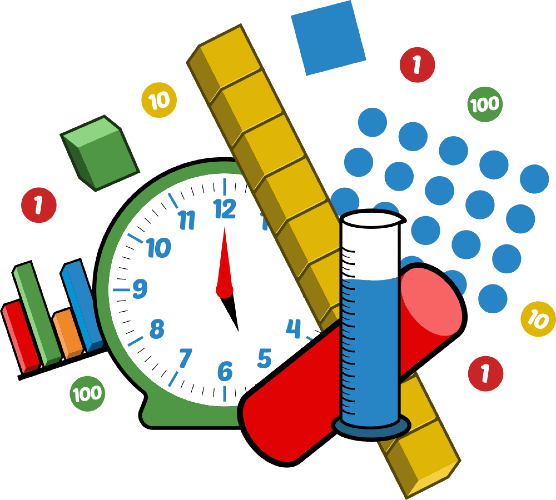
Maths Activities

Number and Place Value
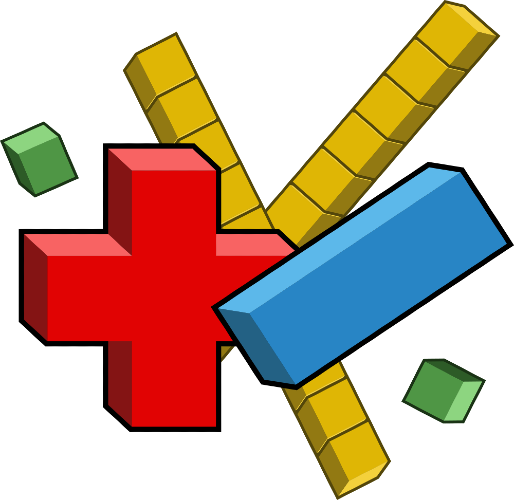
Addition and Subtraction

Multiplication and Division
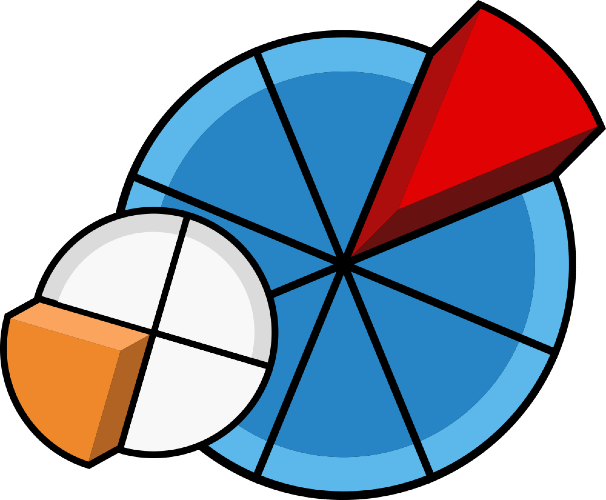
Measurement

Teacher Assessment Framework

Working at Greater Depth

Working towards age-related expectations

Working within age-related expectations
Download our free teaching slides, 20/21 curriculum free teaching slides, love our lesson plans.
Get more teaching tips and worksheets by signing up to our mailing list.
" * " indicates required fields
Join for Free
Subscribe today for access to all of our free resources.
Get In Touch
Got a question about this resource? Leave a message and we’ll get back to you.
Get £10 off your first lesson on PMT Tuition. Use the code PMTAPRIL10 . Book before 30 April, new accounts only.

Edexcel Statistics & Mechanics Year 2 SolutionBank

Yllka E. ★ 5.0 (3)
King's college london - bsc physics.
Warm and bubbly qualified Physics and Maths teacher, with years of experience teaching in class and 1-to-1.
- Qualified Teacher
Ch. 1: Regression, Correlation and Hypothesis Testing
- Exercise 1A
- Exercise 1B
- Exercise 1C
- Mixed Exercise 1
Ch. 2: Conditional Probability
- Exercise 2A
- Exercise 2B
- Exercise 2C
- Exercise 2D
- Exercise 2E
- Mixed Exercise 2
Ch. 3: The Normal Distribution
- Exercise 3A
- Exercise 3B
- Exercise 3C
- Exercise 3D
- Exercise 3E
- Exercise 3F
- Exercise 3G
- Mixed Exercise 3
Ch. 4: Moments
- Exercise 4A
- Exercise 4B
- Exercise 4C
- Exercise 4D
- Exercise 4E
- Mixed Exercise 4
Ch. 5: Forces and Friction
- Exercise 5A
- Exercise 5B
- Exercise 5C
- Mixed Exercise 5
Ch. 6: Projectiles
- Exercise 6A
- Exercise 6B
- Exercise 6C
- Exercise 6D
- Mixed Exercise 6
Ch. 7: Applications of Forces
- Exercise 7A
- Exercise 7B
- Exercise 7C
- Exercise 7D
- Exercise 7E
- Exercise 7F
- Mixed Exercise 7
Ch. 8: Further Kinematics
- Exercise 8A
- Exercise 8B
- Exercise 8C
- Exercise 8D
- Exercise 8E
- Mixed Exercise 8
Review Exercises
- Review Exercise 1
- Review Exercise 2
- Practice Exam Paper
Connect with PMT Education!
- Revision Courses
- Past Papers
- Solution Banks
- University Admissions
- Numerical Reasoning
- Legal Notices

- Home Learning
- Free Resources
- New Resources
- Free resources
- New resources
- Filter resources
- Childrens mental health
- Easter resources
Internet Explorer is out of date!
For greater security and performance, please consider updating to one of the following free browsers
Statistics Consolidation Year 2 Spring Block 2 Reasoning and Problem Solving
Statistics consolidation year 2 spring block 2 questions.
These Statistics worksheets are fantastic at helping your pupils practice their reasoning and problem solving skills. This pack contains two different question types for Year 2 Spring Block 2.

Not a member? Sign up here.
What's included in the pack?
This pack includes:
- Statistics Consolidation Year 2 Spring Block 2 Reasoning and Problem Solving worksheets (includes answers).
National Curriculum Objectives
Mathematics Year 2: (2S1) Interpret and construct simple pictograms, tally charts, block diagrams and simple tables
Mathematics Year 2: (2S2a) Ask and answer simple questions by counting the number of objects in each category and sorting the categories by quantity
Mathematics Year 2: (2S2b) Ask and answer questions about totalling and comparing categorical data
Small Steps:
Make tally charts
Draw pictograms (1-1 )
Interpret pictograms (1-1)
Draw pictograms (2, 5 and 10)
Interpret pictograms (2, 5 and 10)
Block diagrams
This resource is available to download with a Premium subscription.
Our Mission
To help our customers achieve a life/work balance and understand their differing needs by providing resources of outstanding quality and choice alongside excellent customer support..
Yes, I want that!
Keep up to date by liking our Facebook page:
Membership login, stay in touch.
01422 419608
[email protected]
Interested in getting weekly updates from us? Then sign up to our newsletter here!

Information

- Cookie Policy
- Privacy Policy
- Terms and Conditions
Copyright: Classroom Secrets 2024
Company number: 8401067
VAT number: 248 8245 74
- Terms & Conditions
Designed by Classroom Secrets
Statistics and Probability Worksheets
Welcome to the statistics and probability page at Math-Drills.com where there is a 100% chance of learning something! This page includes Statistics worksheets including collecting and organizing data, measures of central tendency (mean, median, mode and range) and probability.
Students spend their lives collecting, organizing, and analyzing data, so why not teach them a few skills to help them on their way. Data management is probably best done on authentic tasks that will engage students in their own learning. They can collect their own data on topics that interest them. For example, have you ever wondered if everyone shares the same taste in music as you? Perhaps a survey, a couple of graphs and a few analysis sentences will give you an idea.
Statistics has applications in many different fields of study. Budding scientists, stock market brokers, marketing geniuses, and many other pursuits will involve managing data on a daily basis. Teaching students critical thinking skills related to analyzing data they are presented will enable them to make crucial and informed decisions throughout their lives.
Probability is a topic in math that crosses over to several other skills such as decimals, percents, multiplication, division, fractions, etc. Probability worksheets will help students to practice all of these skills with a chance of success!
Most Popular Statistics and Probability Worksheets this Week
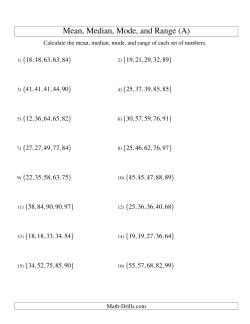
Mean, Median, Mode and Range Worksheets
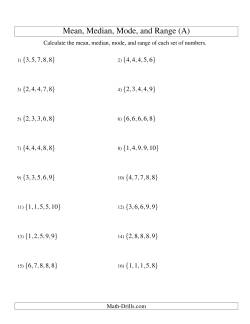
Calculating the mean, median, mode and range are staples of the upper elementary math curriculum. Here you will find worksheets for practicing the calculation of mean, median, mode and range. In case you're not familiar with these concepts, here is how to calculate each one. To calculate the mean, add all of the numbers in the set together and divide that sum by the number of numbers in the set. To calculate the median, first arrange the numbers in order, then locate the middle number. In sets where there are an even number of numbers, calculate the mean of the two middle numbers. To calculate the mode, look for numbers that repeat. If there is only one of each number, the set has no mode. If there are doubles of two different numbers and there are more numbers in the set, the set has two modes. If there are triples of three different numbers and there are more numbers in the set, the set has three modes, and so on. The range is calculated by subtracting the least number from the greatest number.
Note that all of the measures of central tendency are included on each page, but you don't need to assign them all if you aren't working on them all. If you're only working on mean, only assign students to calculate the mean.
In order to determine the median, it is necessary to have your numbers sorted. It is also helpful in determining the mode and range. To expedite the process, these first worksheets include the lists of numbers already sorted.
- Calculating Mean, Median, Mode and Range from Sorted Lists Sets of 5 Numbers from 1 to 10 Sets of 5 Numbers from 10 to 99 Sets of 5 Numbers from 100 to 999 Sets of 10 Numbers from 1 to 10 Sets of 10 Numbers from 10 to 99 Sets of 10 Numbers from 100 to 999 Sets of 20 Numbers from 10 to 99 Sets of 15 Numbers from 100 to 999
Normally, data does not come in a sorted list, so these worksheets are a little more realistic. To find some of the statistics, it will be easier for students to put the numbers in order first.
- Calculating Mean, Median, Mode and Range from Unsorted Lists Sets of 5 Numbers from 1 to 10 Sets of 5 Numbers from 10 to 99 Sets of 5 Numbers from 100 to 999 Sets of 10 Numbers from 1 to 10 Sets of 10 Numbers from 10 to 99 Sets of 10 Numbers from 100 to 999 Sets of 20 Numbers from 10 to 99 Sets of 15 Numbers from 100 to 999
Collecting and Organizing Data
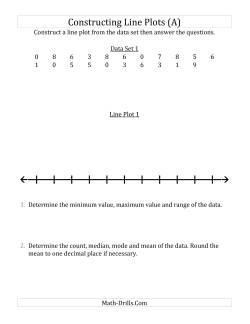
Teaching students how to collect and organize data enables them to develop skills that will enable them to study topics in statistics with more confidence and deeper understanding.
- Constructing Line Plots from Small Data Sets Construct Line Plots with Smaller Numbers and Lines with Ticks Provided (Small Data Set) Construct Line Plots with Smaller Numbers and Lines Only Provided (Small Data Set) Construct Line Plots with Smaller Numbers (Small Data Set) Construct Line Plots with Larger Numbers and Lines with Ticks Provided (Small Data Set) Construct Line Plots with Larger Numbers and Lines Only Provided (Small Data Set) Construct Line Plots with Larger Numbers (Small Data Set)
- Constructing Line Plots from Larger Data Sets Construct Line Plots with Smaller Numbers and Lines with Ticks Provided Construct Line Plots with Smaller Numbers and Lines Only Provided Construct Line Plots with Smaller Numbers Construct Line Plots with Larger Numbers and Lines with Ticks Provided Construct Line Plots with Larger Numbers and Lines Only Provided Construct Line Plots with Larger Numbers
Interpreting and Analyzing Data
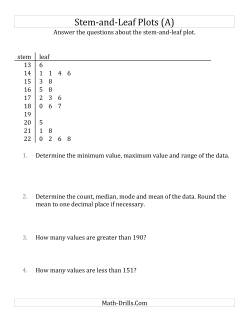
Answering questions about graphs and other data helps students build critical thinking skills. Standard questions include determining the minimum, maximum, range, count, median, mode, and mean.
- Answering Questions About Stem-and-Leaf Plots Stem-and-Leaf Plots with about 25 data points Stem-and-Leaf Plots with about 50 data points Stem-and-Leaf Plots with about 100 data points
- Answering Questions About Line Plots Line Plots with Smaller Data Sets and Smaller Numbers Line Plots with Smaller Data Sets and Larger Numbers Line Plots with Larger Data Sets and Smaller Numbers Line Plots with Larger Data Sets and Larger Numbers
- Answering Questions About Broken-Line Graphs Answer Questions About Broken-Line Graphs
- Answering Questions About Circle Graphs Circle Graph Questions (Color Version) Circle Graph Questions (Black and White Version) Circle Graphs No Questions (Color Version) Circle Graphs No Questions (Black and White Version)
- Answering Questions About Pictographs Answer Questions About Pictographs
Probability Worksheets
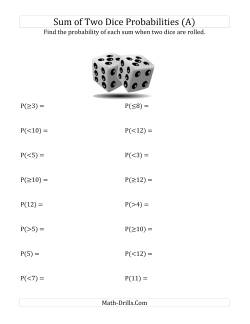
- Calculating Probabilities with Dice Sum of Two Dice Probabilities Sum of Two Dice Probabilities (with table)
Spinners can be used for probability experiments or for theoretical probability. Students should intuitively know that a number that is more common on a spinner will come up more often. Spinning 100 or more times and tallying the results should get them close to the theoretical probability. The more sections there are, the more spins will be needed.
- Calculating Probabilities with Number Spinners Number Spinner Probability (4 Sections) Number Spinner Probability (5 Sections) Number Spinner Probability (6 Sections) Number Spinner Probability (7 Sections) Number Spinner Probability (8 Sections) Number Spinner Probability (9 Sections) Number Spinner Probability (10 Sections) Number Spinner Probability (11 Sections) Number Spinner Probability (12 Sections)
Non-numerical spinners can be used for experimental or theoretical probability. There are basic questions on every version with a couple extra questions on the A and B versions. Teachers and students can make up other questions to ask and conduct experiments or calculate the theoretical probability. Print copies for everyone or display on an interactive white board.
- Probability with Single-Event Spinners Animal Spinner Probability ( 4 Sections) Animal Spinner Probability ( 5 Sections) Animal Spinner Probability ( 10 Sections) Letter Spinner Probability ( 4 Sections) Letter Spinner Probability ( 5 Sections) Letter Spinner Probability ( 10 Sections) Color Spinner Probability ( 4 Sections) Color Spinner Probability ( 5 Sections) Color Spinner Probability ( 10 Sections)
- Probability with Multi-Event Spinners Animal/Letter Combined Spinner Probability ( 4 Sections) Animal/Letter Combined Spinner Probability ( 5 Sections) Animal/Letter Combined Spinner Probability ( 10 Sections) Animal/Letter/Color Combined Spinner Probability ( 4 Sections) Animal/Letter/Color Combined Spinner Probability ( 5 Sections) Animal/Letter/Color Combined Spinner Probability ( 10 Sections)
Copyright © 2005-2024 Math-Drills.com You may use the math worksheets on this website according to our Terms of Use to help students learn math.
Reasoning/Problem Solving
Year 2 Reasoning
Many schools are using some of the ideas of the ‘mastery programme’ as used in Singapore and other parts of the Far East. The aim of this programme is to give children a deep understanding and fluency in the fundamentals of maths. Because this understanding is deep it will not have to be re-taught at a later time; something which happens all too often at the moment.
This new approach needs new resources, especially geared towards reasoning and problem solving. Thankfully we have always considered reasoning to be a key part of the maths curriculum and many of our resources in all categories are designed for this. But we also have a separate category in each year group called, ‘Reasoning and Problem Solving’ where you will find a rich source of material. In Year 2 we have a large selection of ‘How many ways ….’ type of practical exercises (e.g. How many different ways can you score 12 with 3 dice?) These encourage children to think logically and order their results so that they can be sure that they have all possible answers. A favourite of mine is the ‘Two Coin Challenge’. Progressing from these practical tasks are the more abstract challenges such as making 2-digit numbers from a set of number cards.
Finally, take some time out to play the maths games such as Nim which originated in China. They are great at developing logical thinking and developing a winning strategy. You should never lose if you go first! These pages really are not to be missed and we thoroughly recommend them.
Money and shopping
Solving problems involving money and shopping.

What coins could you receive when given 10p change?

What totals can be made from just two coins?

I've got three coins. They are all different. What possible totals could I have?

Can I use just 7 coins to pay all amounts up to 20p?

Solving problems about shopping: quite tricky.

More solving problems about shopping: quite tricky.

Buy shapes which are priced according to the number of sides.
'How many ways' investigations
Challenges which ask how many possible ways there are to solve a problem.

Three boxes and 20 buttons. How many different ways can the buttons be put in the boxes so that each box has an even number?

19 buttons to sort into odd numbers.

How many presents could each of the three girls have got from a total of 20. They all got an even number of presents!

How many ways can the apples be put in the boxes so that there is an even number of apples in each box?

How many ways can the balloons be coloured? A logical thinking exercise.

How many different addition, subtraction and multiplication questions can be made with the cards shown?

How many different addition sentences can be made using the numbers shown?

Create a number plate for the gorillas new car: but you can only use the digits 1, 2 or 3!

How many different ways can various jars be filled with jam?

How many different ways can various buckets be filled with water?

How many different ways can various containers be filled with shampoo?

How many different ways can various containers be filled with bubble bath?

Investigating combinations of fruit.

Investigating combinations of packs of toy farm animals.

Investigating combinations of groups of children.

Find all the ways of jumping forward.

Three very athletic runners sharing a 19 mile relay. They each run an odd number of miles. How could they do this?

Mini investigations into how many different ways totals can be made from three numbers.

A mini investigation for superbrains. How many ways can you make 100, just using the numbers and signs shown?

Can you find 10 different ways of making 12 with 3 cards? (One card is zero, which makes it trickier!)
Number challenges
A variety of number problems and challenges

Making 2-digit numbers.

Using only the numbers 3 and 2 and the + and - signs, can all the numbers up to 20 be made?

A colourful set of number problems involving beads.

Colourful pages on solving number problems involving buttons.

Roll two dice and add the totals. Record and sort the results. What do you notice?
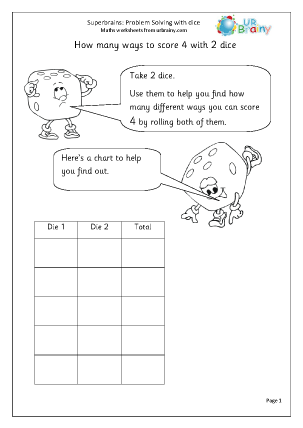
How many different ways can you score a total with two dice?

Using grids to reason about place value of numbers.

Use three dice to see how many different ways a score of 12 can be made.

Solve number problems with dice (1)

More number problems with dice.

Find as many ways as possible to complete the number sentence.

Make and order 2-digit numbers from a selection of number cards.

Number sentences with missing digits using addition, subtraction, multiplication and division.

Recognising that subtraction is the inverse of addition and the relationship between multiplication and division.

All the signs are missing. Find the correct signs to complete the number sentences.

Put the addition or subtraction signs in to make the number sentences correct. Hard, as there is more than one sign!

Problem solving: finding the right sign.

How many patterned tiles are there altogether?

Find how many tiles there are in the pattern.
Further challenges and investigations
More great investigations and challenges for children in Year 2.

Place the toys on the correct shelves.

Use the balance scales to work out which shelves the items go on.

These pages are all to do with sequencing.

Finding the lengths of pencils in a line.

Finding more than the given numbers.

Monsters and legs problems.

Writing addition statements as multiplication.

Put the numbers in the boxes so that the total of the row across adds up to the same as the total of the column down. Several ways to do this, leading to further investigations.

How long will it take to complete a page of addition, subtraction, multiplication and division questions?

Find a route through the maze from IN to OUT adding the numbers as you go.

Dominoes are a great resource for sorting. Try these ideas to begin with.

Roll two dice and add the totals. Record and sort results.

Sam's got a great aim but how many can he score with four beanbags?

What possible scores could I get with four darts?

Harder four dart totals.
Word problems
Use knowledge of maths to solve problems written in words.

Some tricky word problems to solve.

A great selection of one and two-step word problems.

More tricky one-step and two-step word problems.

Addition and subtraction related to the six digits shown.
A selection of mathematical games for one or more players.

An easy version of the game of Nim. Great for logical thinking and you can always win (if you know what you are doing!)

The very simplest forms of magic squares and some ideas on how to turn them into colour patterns.

How many counters can you place on the grid without getting 3 in a row?

Fill in the puzzle so that every row, column and diagonal contains the numbers 1 to 4.
Subscribe to our newsletter
The latest news, articles, and resources, sent to your inbox weekly.
© Copyright 2011 - 2024 Route One Network Ltd. - URBrainy.com 5.1

IMAGES
VIDEO
COMMENTS
Take a look at the National Curriculum expectations for statistics in Year 2 (age 6-7): Draw pictograms, tally charts, block diagrams, and tables ... Problem solving: Handling data. Use the pictogram graph to answer these maths questions.Take a look. Maths activity books for age 6-7. Browse more maths activity books.
Year 2 (Ages 6-7) Interpreting Data Video Lesson 1- Introducing Interpreting Data. When learning about statistics, children may face some new words that they haven't previously come across. A good recognition and understanding of these keywords will help your topic run smoothly. In the first video lesson in our Year 2 Statistics series, Helen ...
Parents Ages 6 - 7 (Year 2) Year 2 Maths Statistics and Data Handling Ages 6 - 7 (Year 2) Problem Solving and Maths Games Ages 6 - 7 (Year 2) Fractions Ages 6 ... This handy collection of Year 2 statistics and data resources includes activities made by teachers to ensure your home teaching journey is expertly delivered. First of all, you could ...
Use this year 2 maths statistics lesson pack to teach children how to interpret and construct tables. This lesson introduces children to tables and teaches them to interpret them, starting with simple retrieval questions and building to comparing numbers, adding or finding the difference. It also includes our Diving into Mastery resources which provide reasoning and problem-solving activities ...
Differentiated maths resources for Spring Block 2 (Statistics) in small steps for KS1 children in Year 2. Each small step contains a range of resources including a teaching PowerPoint, varied fluency worksheets, reasoning and problem solving worksheets, homework or extension worksheets, discussion problems for collaborative learning, interactive games and a learning video clip.
Probability KS2. These upper primary activities introduce the concept of probability. This collection of activities covers the areas of probability and collecting and analysing data.
PlanIt Maths Year 2 Statistics Lesson Pack 1: Interpreting and Drawing Tables. 4.5 (2 Reviews) PlanIt Maths Year 2 Statistics Lesson Pack 2: Interpreting and Drawing Tally Charts. 4.5 (2 Reviews) PlanIt Maths Year 2 Statistics Lesson Pack 3: Interpreting One-to-One Pictograms. 5.0 (1 Review)
Students are also introduced to the < , > and = symbols to compare and order numbers to 100 and learn to count in steps of 2, 3 and 5 from zero. In Year 2, pupils use place value charts to represent numbers to 100. Pupils should be comfortable with counting in 2s, 5s and 10s and as such, move on to counting in 3s.
In this year 2 maths statistics lesson, children are taught to complete and draw one-to-one pictograms. They complete pictograms using data presented in tables and tally charts, and choose symbols to add to pre-drawn pictogram structures. Our included Diving into Mastery cards offer fluency, reasoning and problem-solving practice.The activities within the lesson meet the year 2 national ...
Study with Quizlet and memorize flashcards containing terms like what is meant by a population?, what is meant by a statistic?, what is meant by a sampling unit? and more.
Reasoning and Problem Solving -Statistics -Year 2 1. Yellow is the most popular colour in Henrietta's class. Various responses; must explain why they think that. Example answer: blue would win as even though yellow was the most popular in Henrietta's class, blue was only 2 votes behind. In Jaylan's
By Nick Barwick - 7 Aug 2018. Hamilton provide an extensive suite of problem-solving maths investigations for Year 2 to facilitate mathematical confidence, investigative inquiry and the development of maths meta skills in 'low floor - high ceiling' activities for all. Explore all our in-depth problem solving investigations for Year 2.
Here you will find a range of math word problems aimed at Year 2 level. Each problem sheet is based on an interesting theme such as parties or the seaside. Using these Year 2 maths worksheets will help your child to: Add and subtract with numbers to 12; order numbers to 100; solve a range of math problems.
Now and Then. Age 7 to 11. Challenge Level. Look at the changes in results on some of the athletics track events at the Olympic Games in 1908 and 1948. Compare the results for 2012. These KS2 tasks build on the skills of systematically collecting and interpreting data.
2014 National Curriculum Resources Maths Key Stage 1 - Year 1, Year 2 Year 2 Statistics Ask and answer questions about totalling and comparing categorical data. Parents Ages 5 - 11 Everything You Need for Children Aged 5 - 11 Parents Ages 6 - 7 (Year 2) Year 2 Maths Statistics and Data Handling Ages 6 - 7 (Year 2)
Block 2 - Statistics. Week 5; Week 6; Block 3 - Geometry: Properties of Shape. Week 7; Week 8; Week 9; Block 4 - Number: Fractions. Week 10; Week 11; Week 12; ... Year: Problem Solving & 2 . Pages: 2 . Answers: Yes . A range of mix-topic challenge cards requiring children to use their problem solving and reasoning skills. Photos ;
Discover Year 2 maths worksheets and a range of teaching resources, including teaching slides and interactive videos. About Us. Parents; Free Samples; Blog; ... Problem Solving * Available soon* Statistics: Investigations *Available soon* 20/21 Curriculum Free Teaching Slides. Year 1 Year 2 Year 3 Year 4 Year 5 Year 6. Year 1. Week 1 Week 2 ...
Warm and bubbly qualified Physics and Maths teacher, with years of experience teaching in class and 1-to-1. Approaching end of year exams? Keen to recap everything you learnt in Year 12? Check out our online May Half-term AS-level Maths Recap Courses suitable for all exam boards. Mechanics 26th May, Pure 27-28th May, Statistics 31st May.
Statistics Consolidation Year 2 Spring Block 2 Reasoning and Problem Solving worksheets (includes answers). National Curriculum Objectives. Mathematics Year 2: (2S1) Interpret and construct simple pictograms, tally charts, block diagrams and simple tables. Mathematics Year 2: (2S2a) Ask and answer simple questions by counting the number of ...
Handling data. Year 2 KS1 Maths learning resources for adults, children, parents and teachers.
An assessment paper for children at the end of Year 2 (6-7 years old).Please note these are not intended to be used as a set of written questions where the child answers on paper in silence. The questions could be presented over a period of several days and can be read out loud. Encouraging discussion of the questions will give a much greater ...
Welcome to the statistics and probability page at Math-Drills.com where there is a 100% chance of learning something! This page includes Statistics worksheets including collecting and organizing data, measures of central tendency (mean, median, mode and range) and probability. Students spend their lives collecting, organizing, and analyzing ...
Reasoning/Problem Solving. A selection of problems, challenges and investigations to really stretch the brain! Year 2 Reasoning. Many schools are using some of the ideas of the 'mastery programme' as used in Singapore and other parts of the Far East. The aim of this programme is to give children a deep understanding and fluency in the ...